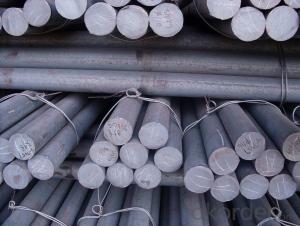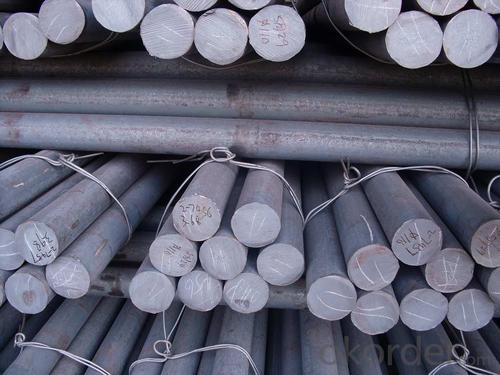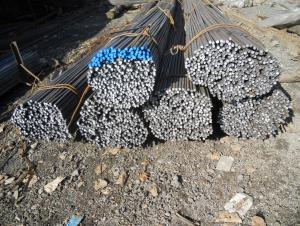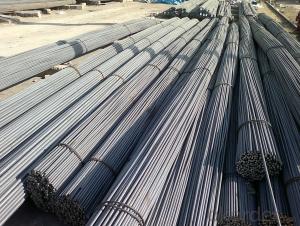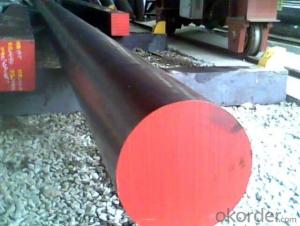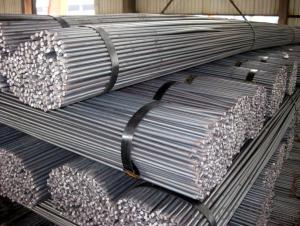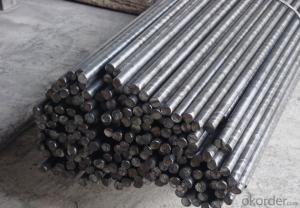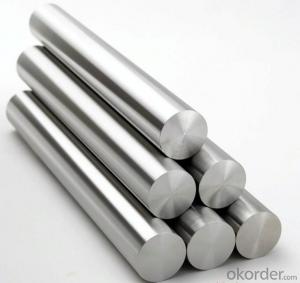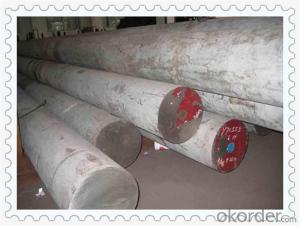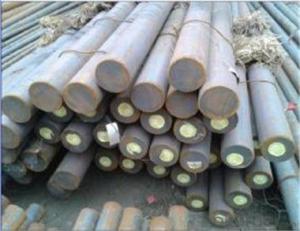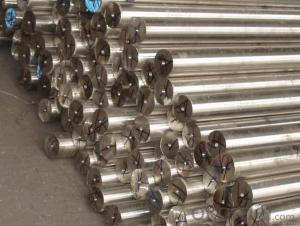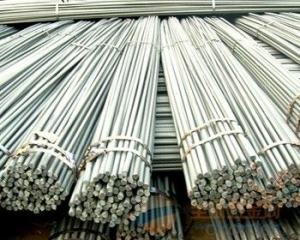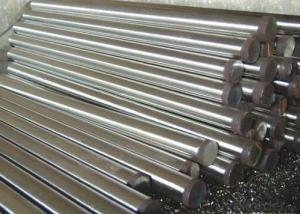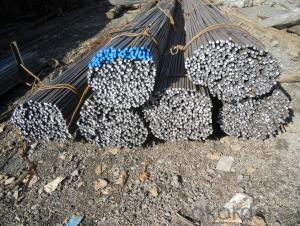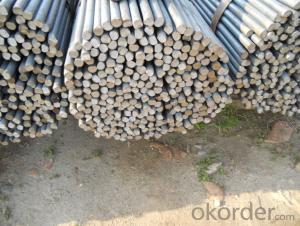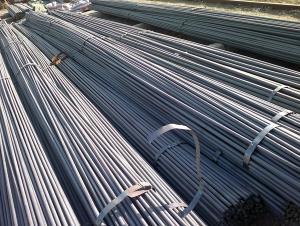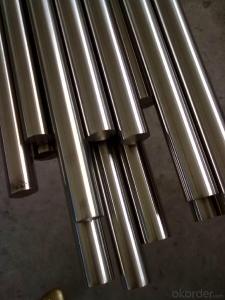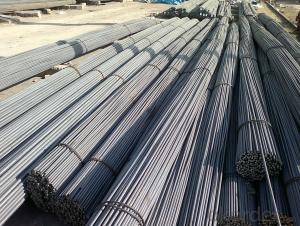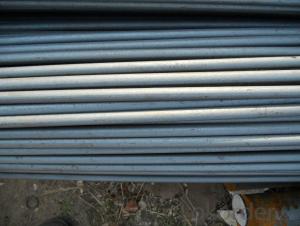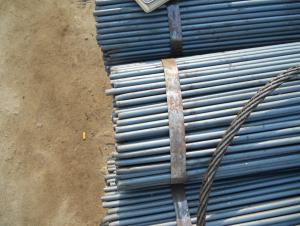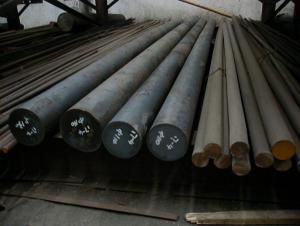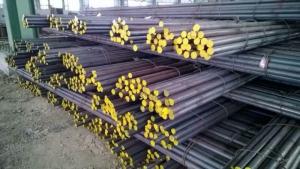Hot sell round steel bar for construction
- Loading Port:
- Tianjin
- Payment Terms:
- TT OR LC
- Min Order Qty:
- 25000 m.t.
- Supply Capability:
- 10000 m.t./month
OKorder Service Pledge
OKorder Financial Service
You Might Also Like
Specifications of Common Steel Round Bar
1. Grade: 304, 316L, 321
2. Type: Mild carbon steel
3. Shape: Round bar, solid bar of steel with circular section
4. Diameter: 8mm-150mm
5. HS Code: 72283010
Usage and Applications of Common Steel Round Bar
1. Common Steel Round Bar of 8-25mm, or small round is mostly used for straight bundles supply, and used for steel, bolts and various mechanical parts. While the bigger round bar, or more than 25mm hot rolled bar, is mainly for the manufacture of mechanical parts or for seamless steel billet.
2. Steel round bar is used in construction and a large number of architectural and engineering structures.
3. Besides, we can supply some especial material steel round bar that can be used for main shaft of steamer, hummer shank, with big section and supper force.
Packaging & Delivery of High Quality Round Bar
Packaging Detail: All goods are packed in bundle with steel strips and shipped by break bulk vessel or container (depend on target market and different ports)
Delivery Detail: 45 days
Trade terms: FOB, CFR, CIF
MOQ: 25 tons per specification; we can negotiate the quantity if the specification is normal or we have stock of one specification.
Weight: The price invoicing on theoretical weight basis or actual weight basis depends on customer’s request.
Shipment: The shipment of bulk break or container is depends on customer’s request and the situation of the port of destination.
Documents given: Full set of original clean on board bill of lading; Original signed commercial invoice; Original packing list; Policy of insurance; Certificate of origin and what the target market needs.
Production Flow of High Quality Round Bar
The common processes are preheated forging quenching, dual refinement solution process, cooling quenching and isothermal quenching. We use heat treatment for dual refinement solution process. The main measures process is high temperature solution and refinement cycle. High temperature solution can improve the carbide morphology and particle size. The aim is to make the loop refinement ultrafine austenite grains.
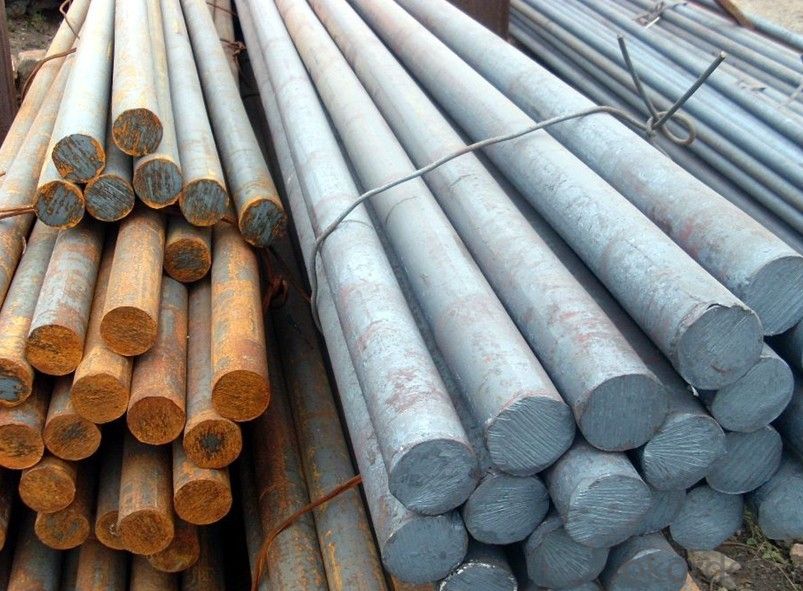
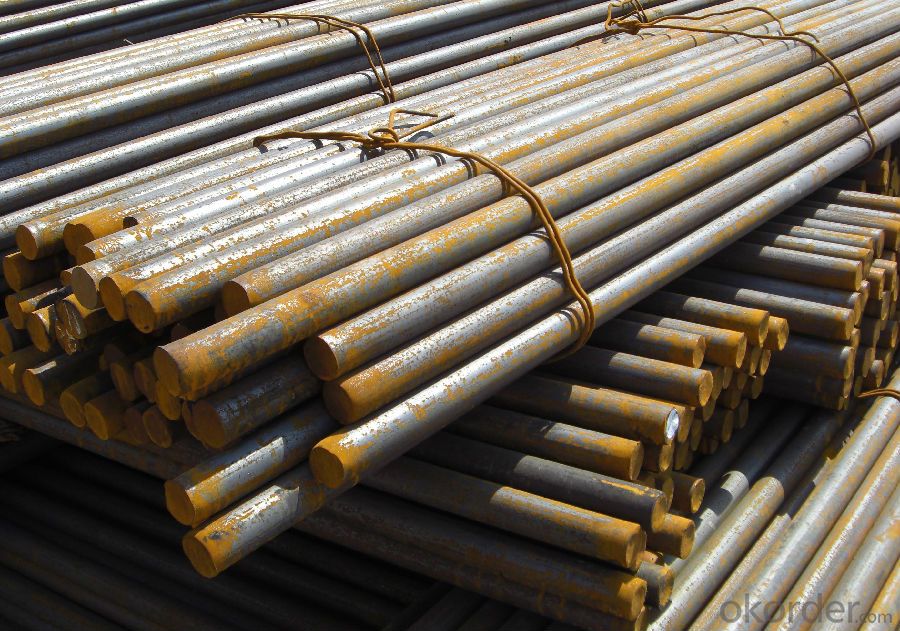
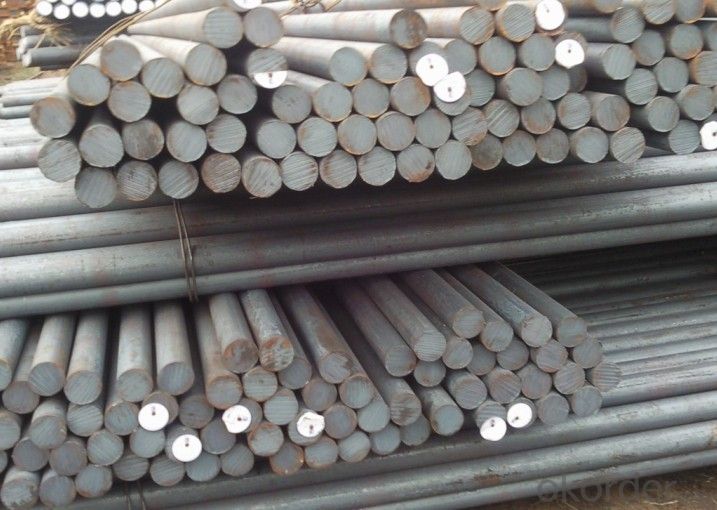
- Q: Are steel round bars susceptible to rust?
- Steel round bars are indeed susceptible to rust. Rust is the result of a chemical reaction between iron and oxygen in the presence of moisture. Since steel is primarily made of iron, it can rust when exposed to air and moisture. However, the susceptibility to rust can be reduced by taking certain preventive measures. Steel round bars can be coated with protective layers such as paint, oil, or galvanized coatings to create a barrier between the steel and the surrounding environment, thus preventing or delaying the onset of rust. Regular maintenance, including cleaning and reapplying protective coatings, can further help in minimizing the risk of rust formation on steel round bars.
- Q: Can steel round bars be bent?
- Yes, steel round bars can be bent. The flexibility of steel allows it to be shaped and manipulated into various forms, including bending round bars into desired angles or curves.
- Q: What are the standard sizes for steel round bars?
- The standard sizes for steel round bars vary depending on the specific industry and application. However, some common standard sizes include 1/4 inch, 3/8 inch, 1/2 inch, 5/8 inch, 3/4 inch, 7/8 inch, 1 inch, 1 1/4 inch, 1 1/2 inch, 1 3/4 inch, 2 inch, 2 1/2 inch, 3 inch, 3 1/2 inch, 4 inch, 4 1/2 inch, 5 inch, 5 1/2 inch, 6 inch, 7 inch, 8 inch, 9 inch, 10 inch, 11 inch, 12 inch, and so on. These sizes are commonly used in construction, manufacturing, and engineering industries, and they may vary slightly depending on the country or region. It is important to note that steel round bars can also be custom-made to specific sizes and lengths to meet the requirements of a particular project.
- Q: Are steel round bars resistant to chemicals?
- The resistance of steel round bars to chemicals can vary depending on the specific steel type and the chemicals involved. Stainless steel round bars are well-known for their exceptional resistance to a wide range of chemicals, including acids, alkalis, and various organic compounds. This is because stainless steel contains high levels of chromium, which creates a protective oxide layer on the surface, preventing corrosion and chemical attacks. However, not all steel round bars possess the same level of chemical resistance. Carbon steel round bars, for example, are more prone to corrosion and chemical attacks compared to stainless steel. Corrosive chemicals, especially in highly corrosive environments, can affect carbon steel and cause damage. In such cases, it may be necessary to use additional protective measures, such as coatings or treatments, to enhance the chemical resistance. To summarize, stainless steel round bars provide excellent chemical resistance, whereas carbon steel round bars may require extra precautions to prevent chemical corrosion. When assessing the chemical resistance of steel round bars, it is crucial to consider the specific steel type, the type of chemical, and the environmental conditions.
- Q: What are the different types of steel round bar surface treatments used in the automotive industry?
- In the automotive industry, the most common types of steel round bar surface treatments used are galvanization, electroplating, and powder coating. Galvanization involves coating the steel with a layer of zinc to protect it from corrosion. Electroplating is a process where a thin layer of another metal, such as chrome or nickel, is applied to the steel surface for enhanced aesthetics and protection. Powder coating, on the other hand, involves applying a dry powder to the steel surface and then curing it under high heat to create a durable and attractive finish. These surface treatments help improve the durability, appearance, and overall performance of steel round bars used in automotive applications.
- Q: What are the advantages of using nickel-alloy steel round bars?
- Nickel-alloy steel round bars offer numerous benefits: 1. Superior strength and durability: Renowned for their exceptional strength and durability, nickel-alloy steel round bars can endure high levels of stress and boast excellent corrosion resistance. Consequently, they are ideal for use in demanding environments. 2. Impressive temperature resistance: With their remarkable temperature resistance properties, nickel-alloy steel round bars retain their strength and integrity even in elevated temperatures. This renders them suitable for applications in industries such as aerospace, power generation, and petrochemicals. 3. Exceptional corrosion resistance: Nickel-alloy steel round bars exhibit outstanding resistance to rust and oxidation, making them highly resistant to corrosion. This quality makes them perfect for deployment in marine environments, chemical plants, and other settings where exposure to corrosive substances is common. 4. Excellent mechanical properties: Boasting outstanding mechanical properties like high tensile strength, toughness, and ductility, nickel-alloy steel round bars can withstand heavy loads and impacts without deformation or failure. As a result, they prove suitable for use in critical structural applications. 5. Versatility and adaptability: Nickel-alloy steel round bars are easily machinable, forgeable, and weldable, offering increased versatility in manufacturing processes. They can be shaped and formed into various sizes and dimensions to meet specific requirements, making them highly adaptable to different industries. 6. Cost-effective solution: Despite their initial higher cost compared to other materials, nickel-alloy steel round bars prove to be a cost-effective choice in the long run. Their resistance to corrosion and wear minimizes maintenance and replacement expenses, resulting in significant cost savings over time. In conclusion, the advantages of nickel-alloy steel round bars lie in their superior strength, impressive temperature resistance, exceptional corrosion resistance, excellent mechanical properties, versatility, adaptability, and cost-effectiveness. These qualities establish them as reliable and efficient options for numerous applications across various industries.
- Q: How do steel round bars contribute to sustainable construction?
- There are multiple ways in which steel round bars contribute to sustainable construction. To begin with, steel is an incredibly durable and long-lasting material. Known for its strength and resilience, steel round bars can withstand heavy loads and extreme weather conditions. This durability ensures that structures built with steel round bars have a longer lifespan, reducing the need for frequent repairs or replacements. As a result, money is saved and the environmental impact associated with the production and disposal of construction materials is reduced. Furthermore, steel is highly recyclable. When a structure reaches the end of its life cycle, the steel round bars can be easily and efficiently recycled. This reduces the demand for virgin steel production, which is both energy-intensive and environmentally harmful. Additionally, recycling steel helps to minimize waste in landfills and conserve natural resources. Moreover, steel round bars can be prefabricated off-site, providing several environmental benefits. This process allows for greater precision and efficiency in construction, reducing material waste and energy consumption. It also minimizes noise, dust, and pollution on-site, making construction projects more sustainable and less disruptive to the surrounding environment. Additionally, steel round bars are frequently used in sustainable building designs. Steel structures can be designed to maximize natural light and ventilation, thereby reducing the need for artificial lighting and air conditioning. This improves energy efficiency and decreases greenhouse gas emissions. Additionally, steel's versatility enables flexible and adaptable designs, making future modifications and extensions easier without significant demolition or waste generation. Lastly, steel round bars are commonly utilized in the construction of green buildings and sustainable infrastructure. These structures are designed to minimize their environmental impact throughout their entire life cycle, from construction to operation and eventual decommissioning. Steel's attributes, such as recyclability, durability, and energy efficiency, make it a preferred choice in sustainable construction practices. In conclusion, steel round bars contribute to sustainable construction through their durability, recyclability, prefabrication opportunities, energy efficiency, and versatility. Incorporating steel into construction projects allows for waste reduction, resource conservation, minimal environmental impact, and the creation of long-lasting structures.
- Q: Are steel round bars suitable for the production of bearings?
- No, steel round bars are not suitable for the production of bearings. Bearings require materials that have specific properties such as high hardness, wear resistance, and low friction coefficient. Steel round bars do not possess these characteristics in their natural state and would need additional processing and treatments to acquire the necessary properties for bearing production. Bearing materials are typically selected from alloys such as stainless steel, chrome steel, or ceramic materials that are specifically engineered to withstand the demanding conditions and provide optimal performance.
- Q: What is the maximum aluminum content allowed for steel round bars?
- The maximum aluminum content allowed for steel round bars varies depending on the specific steel grade and industry standards. In general, the aluminum content in steel round bars is typically limited to a maximum of 0.03-0.06% for most commercial and structural steel grades. However, there are certain specialized steel grades, such as those used in the aerospace industry, where higher levels of aluminum content may be allowed. It is important to consult the specific steel grade's technical specifications or industry standards to determine the maximum allowable aluminum content for steel round bars.
- Q: What is the difference between a cold finished and a hot rolled steel round bar?
- A cold finished steel round bar and a hot rolled steel round bar differ in their manufacturing processes and resulting properties. Cold finished steel round bars are manufactured through a cold drawing process, where the steel is pulled through a die at room temperature. This process results in a smooth, polished surface with tight dimensional tolerances. The cold drawing process also enhances the strength, hardness, and overall mechanical properties of the steel. Cold finished steel round bars are often preferred for applications where precision and a smooth surface are crucial, such as in machinery, automotive parts, and tools. On the other hand, hot rolled steel round bars are manufactured by heating the steel to a high temperature and then rolling it through a series of rollers. This process allows for the shaping and forming of the steel while it is in a pliable state. Hot rolled steel round bars have a rough, scaled surface and looser dimensional tolerances compared to cold finished bars. They also tend to have a slightly lower strength and hardness than their cold finished counterparts. Due to their more affordable cost and ease of production, hot rolled steel round bars are commonly used in construction, structural components, and general fabrication. In summary, the main differences between cold finished and hot rolled steel round bars lie in their manufacturing processes and resulting properties. Cold finished bars offer enhanced strength, precision, and a smooth surface, making them suitable for applications requiring high precision and mechanical performance. Hot rolled bars, on the other hand, have a rougher surface and looser tolerances, but their affordability and ease of production make them a popular choice for general applications.
Send your message to us
Hot sell round steel bar for construction
- Loading Port:
- Tianjin
- Payment Terms:
- TT OR LC
- Min Order Qty:
- 25000 m.t.
- Supply Capability:
- 10000 m.t./month
OKorder Service Pledge
OKorder Financial Service
Similar products
Hot products
Hot Searches
Related keywords
